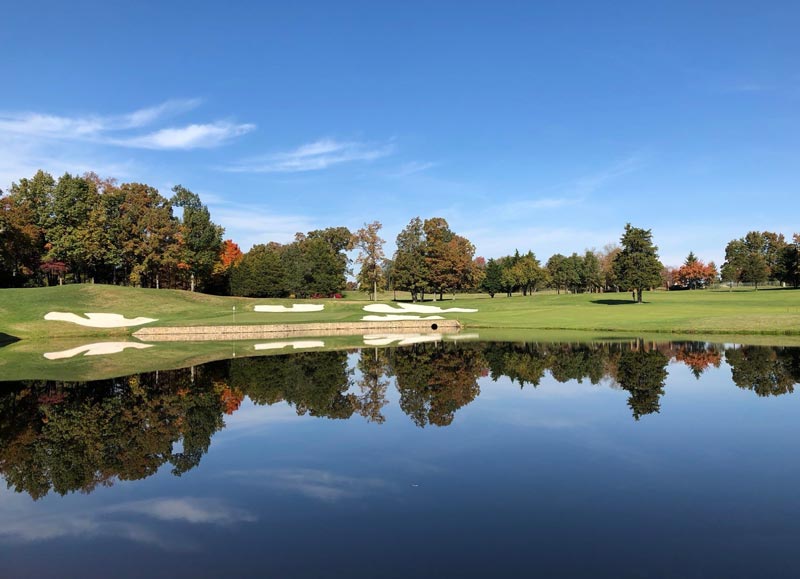
A lake at a country club in Fort Myers, Fla., in which nanobubble aeration is employed. Within a few days — even hours — nanobubble aeration can help restore balance to an aquatic ecosystem affected by poor water quality. Photo courtesy of SOLitude Lake Management
Editor’s note: The following article was supplied by SOLitude Lake Management. All product claims, research cited and other information is directly from the company.
While turf management is the first order of business for golf course superintendents, ponds, lakes and other water features aid in irrigation and accentuate the beauty of the golfscape. Without proper management, though, these features can cause problems that may become a huge detriment to the golf experience. In other words, if your greens and your ponds are the same color, we have a lot to talk about.
Traditionally, herbicides and algicides have been the most reliable solutions to prevalent algae and aquatic weed problems that lead to undesirable odors, erosion and poor water quality. However, many superintendents opt to avoid using these products for a variety of reasons, such as a concern for turf health, budgetary constraints or a desire to be more environmentally friendly. Luckily, proactive strategies and new technologies are making pond and lake management without pesticides easier than ever, with results that last longer.
Combat bad odors and algae
The most obvious and pungent indication of a very unhealthy water body is smelly bacteria, typically recognized as that awful rotten-egg smell, which is caused by hydrogen sulfide gas. As ponds and lakes age, they accumulate organic matter, which originates from a variety of sources that enter the water body, such as dead algae, leaves, branches, and even wildlife and pet feces. As this organic matter settles to the bottom, the microbes and bacteria present in the water will slowly break it down, producing the undesirable scent. It doesn’t end with the smell, unfortunately. This change in water quality conditions often causes the appearance of unsightly algae blooms.
The latest technology available to help improve water quality and prevent dreaded algae blooms is nanobubble aeration, which infuses concentrated dissolved oxygen throughout the water column. Oxygen generators produce ultra-fine, nearly-invisible nanobubbles measuring less than 1 micrometer. Nanobubbles are 1 million times smaller than ordinary bubbles and thus have no natural buoyancy.
The benefits of nanobubble aeration are longer-lasting than those of traditional pond aeration systems. Unlike floating fountains and submersed aerators that improve water oxygenation through surface-rising bubbles, nanobubbles remain within the underwater column for two to three months, providing unparalleled oxygenation and algae prevention throughout that time.
Thwart nuisance and invasive species growth
Aquatic plants are a desirable component for a healthy aquatic ecosystem, but nuisance or invasive plant species can have a negative effect on that ecosystem. Invasive aquatic weeds have the ability to spread and choke out beneficial native vegetation at alarming rates.
An integrated pest management (IPM) approach should be considered when dealing with these nuisance or invasive plants. Very similar to IPM for turfgrass, IPM for ponds and lakes includes biological, cultural and pesticide approaches, with EPA-registered herbicides and algicides used only after all other options have been considered.
For particularly stubborn infestations that have gotten out of hand, consider speaking with your aquatic management professional about ProcellaCOR, one of the latest aquatic technologies on the market. ProcellaCOR is an alternative to traditional aquatic herbicides. It is classified as “reduced risk” and requires extremely low doses to be effective. At these low rates, it’s even possible to irrigate with water that has been treated with this product.
Additionally, ProcellaCOR is highly targeted, meaning it was designed to affect only the growth processes of specific invasive plant species, with no effect on native plants. ProcellaCOR is an excellent option for the removal of milfoil, hydrilla, floating crested heart, water hyacinth, swampweed and many other nuisance and invasive aquatic plants.
Remediate shoreline erosion
Perhaps the most subtle indication of an unhealthy pond or lake is the erosion and eventual collapse of the water shoreline.
Erosion in a water body’s littoral zone (the area where the shoreline meets the water) reduces its depth and overall holding capacity, which can lead to flooding and result in the need for costly dredging. Shoreline erosion can also contribute to undesirable plant growth by providing a nutrient-rich environment for aquatic weeds such as milfoil, hydrilla, water hyacinth and swampweed to colonize. Both the erosion and the presence of invasive weeds can create safety hazards for golfers and maintenance crews.
Inspections and maintenance of your golf course’s lake and stormwater pond shorelines can be the difference between healthy water bodies and smelly, algae-infested eyesores. Routine water quality testing and annual inspections by a lake management professional will help ensure ponds and lakes are in good condition, and such checks will identify any potential issues so they can be addressed before they become larger problems.
The introduction of innovative bioengineered living shoreline technology can help control shoreline erosion. Using a patented degradable woven-mesh system, aquatic management professionals can create a long-lasting sediment containment barrier around a pond or lake. Once the barrier is in place, grasses, native vegetation and deep-rooted plants can be installed into the mesh, forming a beautiful natural buffer.
In addition to being ecologically friendly, living shoreline systems provide a custom solution for every unique property and can also be filled with local sediment or dredged materials from the project site.
The management of a golf course’s lakes and irrigation ponds can be a complicated, delicate process, but new tools and technologies are making the task easier while delivering long-lasting benefits. Contact your aquatic management professional to implement these solutions in your facility’s water bodies.
Benjamin Chen is a fisheries biologist with SOLitude Lake Management, an environmental firm providing sustainable lake, stormwater pond, wetland and fisheries management services. Learn more about this topic on the SOLitude Lake Management website.